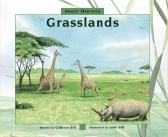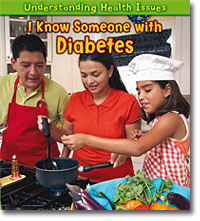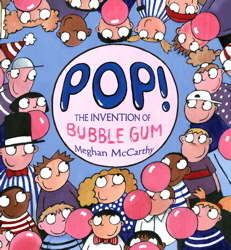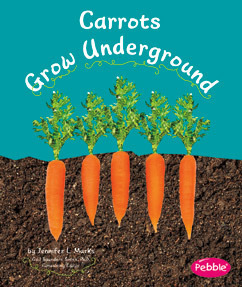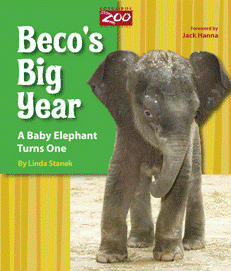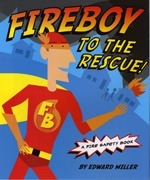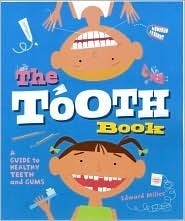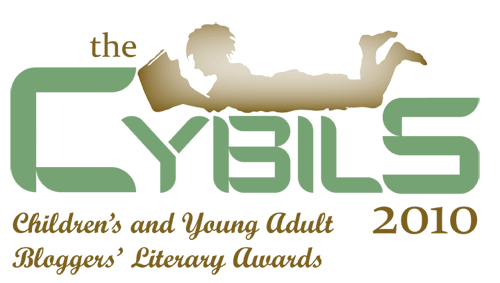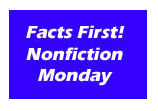Shirley Smith Duke's Blog, page 11
March 1, 2011
GRASSLANDS About Habitats
Grasslands
About Habitats
By Cathryn Sill
Illustrated by John Sill
ISBN# 978-1-56145-559-1
Nonfiction picture book
Grades 1-4
I'm so excited about this new Peachtree book because I was asked to write a teacher's guide for the series About Habitats. finished it and sent it in, so look for it soon on Peachtree's website. I'll add a link from my webpage, too! It's written to be used with any of the About Habitats books or with them all at one time. Check out the other eight Peachtree guides I've written, too!
"Grasslands are large open places where most of the plants are grasses. The grasses may be short, tall, or mixed."
Grasslands is one in a series of books about habitats, their life, and their ecology. Clear, distinctive text narrates the facts about the habitat, its distinguishing characteristics, and the plant and animal life there. This book shows the relationships of the plants and animals and their adaptations and defenses that suit them to this particular habitat.
The Sills' love of science is evident in the text and lovely, full-paged art that adds detail to the information. The front matter shows a world map of major grasslands, a very nice addition to the book, and back matter includes additional information about the art plates, a glossary, bibliography, and websites. Many other books in the About… series relate to individual animals.
Activity
Use a graphic organizer to list all the different grassland habitats in a large group discussion. Then fill in the animals and plants in each one. Using the organizer, write about grasslands as a habitat.
Web cluster graphic organizer
Learn more about grasslands at National Geographic.
National Science Standard: organisms in their environment
Book provided by Peachtree for me to write the series teacher's guide.








February 21, 2011
I Know Someone with Diabetes
I Know Someone with Diabetes
By Vic Parker
Understanding Health Issues
Heinemann Library, 2011
ISBN #9781-4329-4557-2
Nonfiction
Grades 1-3
"You might have a friend with diabetes mellitus, of just called 'diabetes.' Diabetes is a medical condition. This means that a doctor must tell your friend things to do to stay healthy.
This book caught my eye because my father had diabetes in a time when it was more difficult to control. I grew up seeing him take insulin injections daily and observed the results of what the disease can do if it isn't controlled. It's in a series that explains health problems to children. The other book in the series that I read is I Know Someone with Cancer.
This book introduces children to the medical condition diabetes, describes how it affects people, and discusses what they can do to be a friend to someone with the medical condition. It explains insulin and how it changes the sugars in food to energy in their bodies, continuing to tell how diabetics don't have the insulin necessary to do this. The book tells what isn't known about diabetes, and explains the difference between Type 1 and Type 2 diabetes.
In a matter of fact narration, information about controlling diabetes is well explained. Photos clearly show the effects of "going low," or having too little blood sugar for energy. It continues on to explain why they need something sweet when sugar is ordinarily a thing to avoid. The book ends with tips about what friends can do when a diabetic is your friend. The final spread features famous people with diabetes.
The book has a facts and fiction page, glossary, find out more book list, websites, and an index. Straightforward and simple, it shows diabetics living a normal life among friends. That's what is important.
Activity 1
Look over the healthy eating information from the National Diabetes Education Program site. Discuss the importance of eating well for everyone. Use their guidelines to create healthy meals for three days, including snacks.
Learn more about healthy eating here.
Take a look at the changes in portion sizes at this site and take the quiz.
Activity 2
Make a food groups chart and draw examples of healthy foods in their groups.
National Science Standard: develop an understanding of personal health
Book provided by publisher.








February 16, 2011
POP! The Invention of Bubble Gum
Pop! The Invention of Bubble Gum
Meghan McCarthy
Paula Wiseman Book, Simon & Schuster, 2010
ISBN-13: 9781416979708
Nonfiction picture book
Pre-K – 3
"On a small street in Philadelphia in the 1920s, there was a factory owned by the Fleer family….
Inside the factory, lots of gum and candy were made…."
I grew up in a household with a mother who hated chewing gum. Only on certain occasions (Daddy, when he took us to the grocery store on rare trips) were we allowed to buy gum. Smacking was definitely not in the picture! Sadly, I inherited the non-chewing gum gene and still don't care for it. As for the smacking—it drives me crazy. But I did buy it for my kids! Here's a book that celebrates gum, inventors, and all the repetition that goes with science.
Gum has been around for a long time, but it took accountant Walter Diemer try after try to create a gum that allowed the chewer to blow bubbles. His success eventually promoted him to vice president, although he never got rich. But he made many kids happy around the world.
McCarthy uses her familiar round eyes to create the cartoon-style illustrations that add detail to the book. The drab factory colors at the start of the book increases to bright bubblegum pink by the end. and lets the reader celebrate the success of gum created for blowing bubbles. The brief, narrative text relates the history and behind-the-scenes story of how bubble gum came to be.
Back matter completes the book with gum facts, more about Walter Diemer, additional facts, and a detailed list of sources. A happy story of persevering in the face of failure comes from Pop! and kids are sure to love it.
Activity 1
Design an experiment to test the flavor of different varieties of bubble gum. Examine the gum and record qualitative observations (those you can see, smell, hear, etc). Discuss chewing the gum and how you can set the controls to keep the experiment equal. Choose three flavors and time them as the kids chew. Record the time when there is no flavor left. Rinse mouths and eat a cracker, and test the other brands. Record the results and repeat the process. Make a graph comparing the times.
Create your own graph here.
Here's a fun site about graphs.
Good examples of how a graph works.
Activity 2
Blow bubbles and decide on a way to measure them. Let the kids figure out a way!
More about gum's history.
National science standard: understanding about scientific inquiry
Book provided by publisher for Cybils consideration.








February 8, 2011
Carrots Grow Underground
Carrots Grow Underground
By Mari Schuh
Pebble Books/Capstone, 2011
How Fruits and Vegetables Grow series
ISBN #9781429652803
Pre-K – 2nd grade
Nonfiction
"Green stems and leaves sprout from the soil. Underground, vegetables grow larger and larger every day."
A big box of books arrived from Capstone today and this one with carrots in dirt on the front caught my eye right away. The trim size feels good in your hand and early readers should delight in reading about things that grow underground. I always am amazed at the way authors manage to convey information and ideas with a vocabulary just right for early readers. But simple words don't mean a lack of information!
Carrots Grow Underground follows the life cycle of growing root vegetables and the process they go through while developing. I like that the author included parsnips, too. From seeds to harvest, the book follows root vegetables and up close photos illustrate the text. This fun-sized book has a glossary, Read More section, websites, and an index. This is an excellent way to introduce young readers to nonfiction and the joy of science.
Activity
Get a package of carrot seeds. Put a few in a plastic bag with wet paper towels and watch them germinate. You might want to add beans and radishes for young kids, since carrots take a longer time to get going. Then plant some of the carrot seeds in a pot and plant some in the flowerbed or garden. Count the days it takes for them to sprout. Track their growth and pull up one at intervals to see the root hairs form as the carrot grows. Use a real carrot to study until yours grow up! Cut one open and examine the insides.
Here's how to plant your carrots.
Here's more carrot growing information.
Make dinner with carrots!
Other books in the series:
Apples Grow on a Tree, Blueberries Grow on a Bush, Lettuce Grows on the Ground, Tomatoes Grow on a Vine
National Science Standard: life cycle of organisms
Book provided by publisher.








February 1, 2011
Yucky Worms
Yucky Worms
By Vivian French
Illustrated by Jessica Ahlberg
Candlewick Press, 2010
ISBN #987-0-7636-4446-8
Grades Pre-K – 3
Story with facts
"One day when I was in Grandma's garden, Grandma dug up a slimy, slither, wiggly worm.
'Yuck!" I said. "Throw it away!'"
Thank goodness Grandma refused to throw it away. The story goes on to show and tell how worms benefit the garden with its castings and hole digging. The story continues with a sassy worm inset scattered about some of the pages and relates the value of worms, which are really yucky at all. The story ends with the little boy convinced he's got lots of new friends—worms!
The back matter has worm tips, experiments, and a short index. The soft watercolor is attractive and just right for the book's feel. The text is informative and the book ran a close race for the Cybils NFPB finalist list. It's a fun read with lots of good information and one that kids will enjoy.
Activity
Get a worm using the methods described in the book or at a bait store. Moisten a paper towel and lay the worm out. Take care not to harm the worm. Use a magnifying glass to identify the parts discussed in the book. When you finish, put the worm in your own garden.
All About Earthworms has a fun site to explore.
Learn new vocabulary here.
National Science Standard: organisms and their environment.
Book provided by publisher for Cybils consideration.








January 26, 2011
Beco's Big Year
I wrote the post and filed it incorrectly in my "Secret Life of Scientists" blog file, thinking I'd scheduled it. I just remembered, so here's the adorable Beco, the baby elephant.
Beco's Big Year
A Baby Elephant Turns One
By Linda Stanek
Forward by Jack Hanna
Columbus Zoological Park Association, 2010
Grades K-4
Nonfiction
"For almost two years, the people at the Columbus Zoo watch and wait. An Asian elephant named Phoebe gets bigger and bigger and bigger. Animal doctors, called, vets, have great news. Phoebe is going to have a baby! Before, she weighed 6,800 pounds. As her baby grows, Phoebe gains more than a thousand pounds. Now, she is up to almost 8,000 pounds."
What's not to like about the adorable baby elephant on the cover of this book? It traces the pregnancy of Phoebe, an elephant at the Columbus Zoo, through the birth of her calf Beco and the baby's first year of life. This is an up-close and accessible look at this baby called Beco.
The text narrates the event while providing additional information about elephants and their life in the zoo. It includes information about elephants in general, babies and their early days, name choosing, how the baby learns, and training procedures that allow vets to examine and care for these pachyderms.
Sidebars throughout the book add more facts that will interest independent readers or older children, but the main text is easily accessible. Loads of photos follow Beco's development and provide an appealing insight into the life of Beco, her son, and elephants.
The book is fascinating and should appeal as a fact gathering book, a great story time nonfiction book, or just a fun read or picture study. I liked the book so much, and it's so well written and designed, I wanted in as a finalist in the NFPB Cybils. It's one every library should have because every youngster will enjoy it.
Activity 1
Make an outline of Asia and Africa. Use the outlines to create a comparison of Asian and African elephants.
National Geographic has good elephant information.
Activity 2
Make a timeline of Beco's first year. Chose 5-7 events in Beco's life, or more! Highlight events and developments by Beco of his first year of life.
See Beco's 2nd birthday celebration.
Here's another review of Beco's Big Year at NC Teacher Stuff.
Book provided by Columbus Zoological Park Association for Cybils NFPB consideration.
National Science Standard: life cycle of organisms








January 18, 2011
FIREBOY to the Rescue
Fireboy to the Rescue
By Edward Miller
Holiday House, 2010
ISBN #9780823422227
Ages 3-8
Nonfiction picture book
"I'm Fireboy, and I'm here to defend you from all things that could burn. A dangerous and scary fire can break out anyplace, anytime. I'm on the lookout to keep you, your family, and your neighborhood safe from harm!"
The cartoony character Fireboy, an angular hero in bright red, narrates a story of safety rules for dealing with and preventing fires. The word bubbles lend it a graphic novel feel with great reading ease. Exciting pictures illustrate the points of safety and add visual emphasis to what the kids should do. Batman style sounds punctuate the book and make the energetic feel even stronger.
The bright colors are appealing and the writing is straightforward and simple enough for young children to understand, while at the same time appealing to the older ones as they reinforce fire safety.
I wasn't sure I'd like the book when I picked it up, but it's turned out to be a wonderful, fun book. It was one of the Cybils nominees I strongly considered and I think kids as well as parents and teachers will love it as much as I did. It would work well for a fire safety unit, fire prevention week, or simply as a fun read about interesting things.
Activity
Create your own safety cartoon character. Write a comic book panel of 4-8 sections to illustrate another safety rule. You might want to consider electrical safety, water safety, automobile safety, or any other thing you can use to illustrate safety procedures.
School classes may want to add fire drills in an additional panel for a simple activity.
I should have known I'd like this book—he also wrote and illustrated The Tooth Book, one I loved and wrote about from last year. Here's the post on it.
National Science Standard: personal health
Book provided by publisher for Cybils committee.








January 11, 2011
MAMMOTHS AND MASTODONS
Mammoths and Mastodons
Titans of the Ice Age
By Cheryl Bardoe
Abrams Books for Young Readers, 2010
In association with The Field Museum, Chicago
ISBN #0-8109-8413-X
Grades 3-7
Nonfiction
48 pages
This book is one of my favorites. It came my way through the nonfiction picture book category of the Cybils, the blogger award. It was one I championed and one not to miss with its fascinating story of these legendary mammoths of the Ice Age. While I review many picture books, I feel this book is far more. Take a look at it.
"Ten-year-old Kostia squinted through the snow that blows across northern Siberia even in May. He and his brother Edik had just loaded their reindeer sledge with firewood when they noticed an odd lump by the river. Kostia guessed it was an injured reindeer. But when the brothers drew closer, Kostia could hardly believe his eyes. The strange dead animal had no antlers—but it had a trunk like an elephant. Kostia and Edik poked at the animal and then hurried home."
I remember the excitement when this baby mammoth named Lyuba was found in Siberia. After this astonishing find—an entire frozen baby woolly mammoth—scientists had the unique opportunity to study this extinct species. This find provided information that traced the relationship of mammoths, mastodons, and modern elephants and may provide clues to saving the elephant from extinction.
Scientists pieced together fossil information along with this find to present theories and attempt to answer questions concerning these huge mammals from the past. Bardoe presents the story of the find and presents the latest research in a fascinating story. Diagrams, photographs, and art with captions add to the information to create a readable story of this now extinct group of Ice Age titans. From cave art to the current day elephant, this book opens the door to the latest body of knowledge about these animals.
The book combines up-to-date research with a wondrous, story narrative that is sure to interest any animal lover. It's a great way to introduce the process of science and how science works to uncover answers to some of our greatest mysteries.
Activity
Compare the Asian elephant with the African elephant. Find the similarities and differences. Create a chart or diagram to illustrate the mammoths, mastodons, and elephant and show their characteristics.
This site has good information.
This site has information and photos of Lubya.
National Science standard: understandings about scientific inquiry; populations and ecosystems; structure and function is living organisms
Book provided by publisher to Cybils committee members








January 4, 2011
Journey into the Deep
Journey into the Deep
Discovering New Ocean Creatures
By Rebecca L. Johnson
Millbrook Press, 2011
Series: Exceptional Science Titles for Intermediate Grades
ISBN-13: 978-0-7613-4148-2
Grades 4-8
Nonfiction
Happy New Year! I'm kicking off this year with a new 2011 book that I loved. Thank you all for joining me as I begin my third year of blogging about books and science.
"Like a spaceship from a distant galaxy, the massive jellyfish hovers in the frigid water. Its meaty dome-shaped bell is as wide as a doorway and the color of a bad bruise. Beneath the bell, fleshy arms twist and sway. The bell contracts and the jellyfish glides backward. It relaxes, then contracts again. Contract, glide, relax. Contract, glide, relax. With a steady rhythm, the jellyfish pulses through the utter darkness of the deep sea."
The deepest part of the sea is one of the last frontiers, and Journey into the Deep takes the reader to the depths of that frontier. You'll see previously unknown species of life in close-up photographs and read about them in detail as you travel in the "living minestrone" and learn of the myriad life forms science is just beginning to find in the world cooperative Census of Marine Life.
Graphics mix well with sharp, close-up photographs of astonishing animal life amid the variety of ocean habitats. Sidebars give additional information relating to the study of science and the life depicted within the text. Detailed captions provide extra information to accompany the fascinating array of life forms.
This visually stunning book is informative and would fit well into upper elementary and middle school libraries. With the vast amount of scientific information appearing, this book is an excellent way to stay abreast of the latest research and findings. I read every bit of the text and reveled in the discoveries so beautifully documented on each spread.
Activity 1
Trace a food chain or web around one of the deep sea hydrothermal vents. Identify the adaptations each life form has that allow them to live within such a harsh environment.
See additional information about deep sea hydrothermal vents here.
More information about vents.
Activity 2
Define and explain chemosynthesis. Then compare it to photosynthesis.
This site gives information about chemosynthesis and hydrothermal vents.
Learn more about the whale decomposition studies being carried out at the University of Hawaii.
Roberta at Wrapped in Foil has an excellent review of this book, too.
National science standard: Populations and ecosystems; diversity and adaptations of organisms; structure and function of living organisms
Book provided by publisher.








January 2, 2011
CYBILS Nonfiction Picture Book Finalists
2010 Finalists
Nonfiction Picture Books
They're here! Choosing from the huge number of great entries was fun and enlightening. Here are the finalists.
 Bones
Bones
by Steve Jenkins
Scholastic
Nominated by: Mary Ann Scheuer
Young explorers might come across skeleton remains, but in Bones, readers are reminded that skeletons are alive. Jenkins' book delivers all sorts of bones, from snakes to humans to bats and everything else in between. His clever page titles such as "Arm Yourself," "Big Foot," or "Support Group" are engaging. The bone illustrations are created at a variety of scales. Intricate paper cuts for each page, along with the straightforward explanations, won the hearts of the panelists. More skeleton facts, stories, history, and science are at the book's end.
 Dinosaur Mountain: Digging into the Jurassic Age
Dinosaur Mountain: Digging into the Jurassic Age
by Deborah Kogan Ray
Farrar, Straus & Giroux
Nominated by: Raymond Tumarkin
"Find me something big," ordered Andrew Carne, when he sent paleontologist Earl Douglas to an area of the Colorado/Wyoming border now known as Dinosaur National Monument. Deborah Kogan Ray chronicles Douglas' efforts, including his struggles with weather, discouragement and bone poachers. Ray uses journal excerpts, diagrams and pencil sketches of other useful information, such as layers of the Jurassic Strata and paleontologist's tools, to provide additional support for the reader. Prolific appendices include information about ten dinosaurs found in Dinosaur National Monument.
 Henry Aaron's Dream
Henry Aaron's Dream
by Matt Tavares
Candlewick Press
Nominated by: Margo Tanenbaum
Henry Aaron had a dream that some day he'd play baseball in the big leagues, but life in the 1940s made it impossible for blacks and whites to do anything together. Using Jackie Robinson as his inspiration, Aaron persevered and played his way into the big leagues while overcoming prejudice and obstacles. The straightforward narrative pulls the reader along in this emotion-filled story of Aaron's dreams as a child and subsequent path leading him to play baseball professionally. Tavares's large, muted illustrations depict the times, the disappointments, and triumphs of this player from his childhood to his successful record-breaking career. But best of all, it tells the story of how a skinny kid from Mobile, Alabama, made his dreams come true.
 Pop!: The Invention of Bubble Gum
Pop!: The Invention of Bubble Gum
by Meghan McCarthy
Simon & Schuster
Nominated by: Jess Pugh
Chewing gum has been around for thousands of years, but bubble gum was invented by an accountant in Philadelphia. Here, with bright, cartoonish illustrations, Meghan McCarthy tells the story of the invention of one of America's favorite candies. From the subject matter to the vivid colors used throughout, Pop! oozes kid appeal, while back matter includes additional fun facts about bubble gum, biographical information, and source notes. Together, this makes for a book that'll give kids thoughts to chew on.
 Sit-In: How Four Friends Stood Up by Sitting Down
Sit-In: How Four Friends Stood Up by Sitting Down
by Andrea Pinkney
Little, Brown
Nominated by: Allison Moore
In 1960, when four Negro college students decided to sit down and try to order at the Woolworth's lunch counter in Greensboro, North Carolina, they were part of a movement bigger than they even realized. They were peaceful and respectful, even when those around them chose to be cruel and unkind. They held on to their conviction that they had a right to order food if they were hungry, no matter where they were, or what the color of their skin. Most of the story is written as a metaphor for eating, especially the parts about equality, peace and integration. Pinkney ties the story together so well with those metaphors. Brian Pinkney's illustrations are amazing and match the text beautifully. His backgrounds are particularly thoughtful, as that is where the hatred of others can be found in a hazy way. Sit-In serves as a springboard to look at all the ways we can stand up for each other and for what's right, no matter what the color of our skin.
 Skit-Scat Raggedy Cat: Ella Fitzgerald
Skit-Scat Raggedy Cat: Ella Fitzgerald
by Roxane Orgill
Candlewick Press
Nominated by: Derek Jones
Ella Fitzgerald is known for her unique voice and giving the world scat, improvisational singing. Fitzgerald didn't have an easy childhood. Roxane Orgill handles the ups and downs with a skilled hand. We get so much of Ella, from singing with her mother to the time when she had no home. Even through the sadness, Skit-Scat Raggedy Cat never loses its sense of hopeful possibility. Sean Qualls' illustrations are beautiful, from Ella's expressive eyes to the detailed clothes of the era. Orgill and Qualls have collaborated on a lyrical and visually stunning biography on a jazz icon.
 The Extraordinary Mark Twain (According To Susy)
The Extraordinary Mark Twain (According To Susy)
by Barbara Kerley
Scholastic
Nominated by: Jennifer Donovan
Children have no doubt heard of Mark Twain, but here they'll get to know him in a new and more familiar way through the words of his daughter. As a child, Susy Clemens carefully crafted a secret biography of her beloved Papa, and Kerley brings to life both Papa and Susy, as well as Susy's journal, for young readers. Kerley weaves quotes from various sources into a narrative that reads like fiction, and Fotheringham's lively, colorful illustrations portray a larger-than-life Twain and his ever-present biographer. Excerpts from Susy's journals are cleverly presented in small leaflets throughout the book. Back matter includes further information about Mark Twain and Susy, a selected timeline of Twain's life, and detailed sources and citations for quoted material in the text. For readers who are inspired to keep their own secret journals, suggestions for following in Susy's (and Kerley's) pen strokes to write an "extraordinary biography" are provided.
The second round committee has some hard choices to make. Have fun! See the other finalists here.
It's Nonfiction Monday. Join us at Charlotte's Library to see all the entries.








Shirley Smith Duke's Blog


